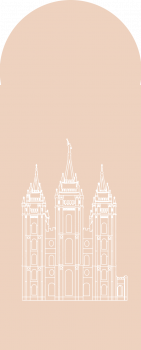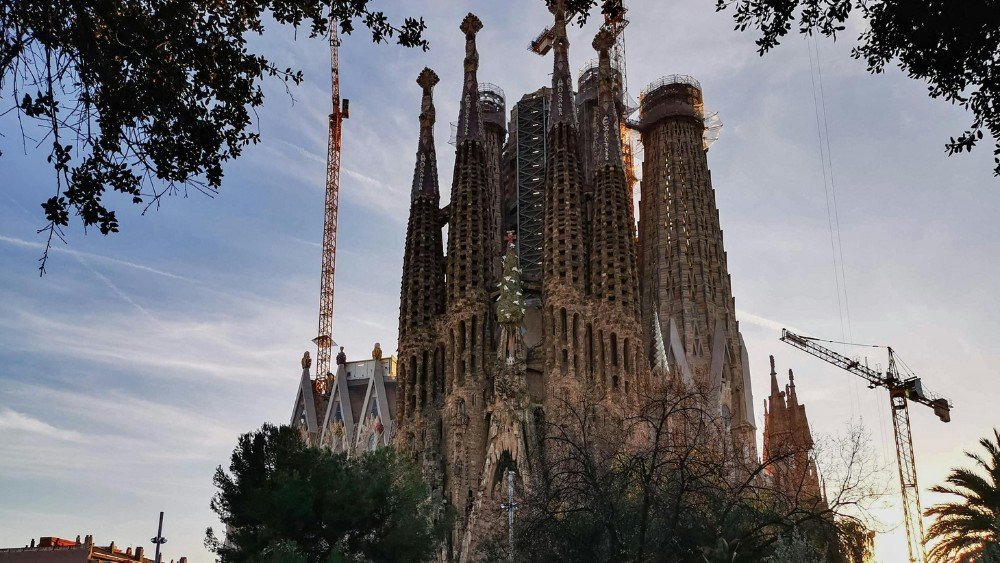A masterpiece in progress, weaving divine inspiration with architectural innovation, where faith meets artistry in the heart of Barcelona.
Ever wondered what it’s like to step into a place where every corner tells a story of faith, art, and endless dedication?
Welcome to the Sagrada Família, an architectural marvel that’s been touching the sky and hearts alike for over a century.
Picture this: towering spires that seem to converse with the heavens, and intricate facades that narrate tales of devotion and scripture.


Generally 9 AM – 6 PM (varies by season)
Dress respectfully; modest attire is preferred.
Early morning or late afternoon to avoid crowds; spring and fall for pleasant weather.

Wander through Gaudí’s whimsical park, a magical escape near Sagrada Família.

Discover Gaudí’s masterpiece with undulating facades, close to Sagrada Família.

Marvel at this Art Nouveau complex, a stunning example of early 20th-century architecture, just steps from Sagrada Família.
Over 140 years in the making, and still not complete.
Designed by the legendary Antoni Gaudí, blending Gothic and Art Nouveau forms.
Structures mimic trees and natural light filters through like a forest canopy.

Each façade tells a different biblical story, inviting reflection and awe.
Envisioned as a spiritual beacon in the bustling city, welcoming millions from around the globe.
Capture the essence of faith, creativity, and community as you wander through the Sagrada Família, where every stone is a verse and every window a hymn.





The Sagrada Família, a beacon of creativity and devotion, remains a work in progress over 130 years since its inception.
Inspired by Gaudí's unique vision, this temple evolves with time, embodying the ongoing relationship between man's creativity and divine inspiration.
Each generation contributes, making the temple a living legacy of faith through the ages.

Antoni Gaudí, the mastermind behind this breathtaking structure, devoted the latter part of his life entirely to the temple's construction. His commitment was so profound that he resided on-site, immersing himself completely in his divine architectural pursuit.
Gaudí's final days were spent within the walls of his magnum opus, leaving behind a legacy that continues to inspire.

The Sagrada Família's stained glass windows are not just decorative elements but are designed to create an ethereal play of light that symbolizes the transition from darkness to enlightenment.
As sunlight filters through, the interior is bathed in vibrant hues, creating a dynamic tapestry of light that reflects the celestial.

Each of the temple's façades narrates a different biblical story, intricately carved into stone.
The Nativity Façade celebrates the joy of Christ's birth with jubilant figures and flora, while the Passion Façade starkly contrasts with its austere depiction of Christ's suffering, and the Glory Façade, still under construction, promises to encapsulate the road to eternal happiness.

Gaudí envisioned the Sagrada Família as "Nature's Cathedral." The interior columns branch out like trees, creating a canopy overhead, while the intricate designs mirror natural forms, from spiral staircases resembling shells to roof tiles that mimic leaves.
This harmony with nature is a constant reminder of the divine in the everyday.

Rising high above the city, the Sagrada Família's towers are dedicated to biblical figures, each with its own significance.
The tallest tower, yet to be completed, will be dedicated to Jesus Christ and will make the temple the tallest religious building in Europe, symbolizing Jesus as the pinnacle of human endeavor towards divinity.

The construction of the Sagrada Família is a testament to the power of generational legacy, with artisans, architects, and volunteers dedicating their lives to the continuation of Gaudí's vision.
This collective effort symbolizes the unity of community in faith and the enduring human spirit.

Gaudí's use of geometric shapes - hyperboloids, paraboloids, helicoids, and ellipsoids - in the design of the Sagrada Família was revolutionary.
These shapes not only provide structural stability but also create a mesmerizing aesthetic that blurs the lines between architecture and sculpture, inviting contemplation.

Recognized as a UNESCO World Heritage Site, the Sagrada Família is not just an architectural wonder but a symbol of Barcelona's cultural and spiritual heritage.
It stands as a beacon of creativity, faith, and the enduring human endeavor to reach towards the divine.

After Gaudí's untimely death, his original models and plans were destroyed during the Spanish Civil War, leaving the future of the Sagrada Família in jeopardy.
The reconstruction of Gaudí's vision from surviving fragments and photographs is a narrative of resilience and dedication to preserving genius.

The anticipated completion of the Sagrada Família, projected for 2026, the centenary of Gaudí's death, is set to be a historic event.
This culmination will not only mark the end of a monumental architectural journey but will also celebrate the enduring legacy of faith, art, and humanity intertwined in the temple's creation.

The foundation stone of the Sagrada Família is laid in Barcelona, marking the beginning of a monumental journey inspired by faith and artistic vision.

Antoni Gaudí takes over as chief architect, infusing the project with his unique style that blends Gothic and Art Nouveau forms, setting the stage for a century-spanning masterpiece.

Antoni Gaudí takes over as chief architect, infusing the project with his unique style that blends Gothic and Art Nouveau forms, setting the stage for a century-spanning masterpiece.

Gaudí’s vision begins to materialize with the construction of the crypt and the Nativity façade, showcasing elaborate sculptures and intricate designs that celebrate the joy of Jesus Christ’s birth.

Gaudí introduces innovative structural techniques, such as the use of catenary arches and hyperboloid structures, revolutionizing architectural and engineering principles.

Gaudí introduces innovative structural techniques, such as the use of catenary arches and hyperboloid structures, revolutionizing architectural and engineering principles.

Tragically, Gaudí’s life is cut short when he is struck by a tram. Buried in the temple’s crypt, his legacy continues with his disciples and future generations taking up the mantle.

Progress is hindered by the Spanish Civil War; parts of Gaudí’s workshop are destroyed, and original plans are lost, leading to years of reconstruction efforts based on surviving models and drawings.

Progress is hindered by the Spanish Civil War; parts of Gaudí’s workshop are destroyed, and original plans are lost, leading to years of reconstruction efforts based on surviving models and drawings.

Renewed efforts and international interest help resume construction, focusing on the Passion façade, which contrasts the Nativity façade with its stark representation of Christ’s suffering and crucifixion.

Advancements in technology, including computer-aided design, breathe new life into the construction process, allowing Gaudí’s complex geometric forms to be realized with greater accuracy.

Advancements in technology, including computer-aided design, breathe new life into the construction process, allowing Gaudí’s complex geometric forms to be realized with greater accuracy.

Pope Benedict XVI consecrates the Sagrada Família as a basilica, recognizing its significance as a place of worship and its unique contribution to Christian art and architecture.

The construction reaches a new milestone with the completion of the tower dedicated to the Virgin Mary, further adding to the temple’s iconic skyline.

The construction reaches a new milestone with the completion of the tower dedicated to the Virgin Mary, further adding to the temple’s iconic skyline.

The anticipated completion of the Sagrada Família, coinciding with the centenary of Gaudí’s death, aims to fulfill the architect’s visionary design with the completion of the central tower of Jesus Christ, making it the tallest church building in the world.

The Sagrada Família stands as a living canvas, a blend of devotion, artistry, and innovation, attracting millions from around the globe, not only as a testament to Gaudí’s genius but as a sanctuary of faith and inspiration for generations to come.

The Sagrada Família stands as a living canvas, a blend of devotion, artistry, and innovation, attracting millions from around the globe, not only as a testament to Gaudí’s genius but as a sanctuary of faith and inspiration for generations to come.


The Genesis of a Dream
The story of the Sagrada Família begins with a vision, one that sought to encapsulate the essence of faith and humanity in stone and light.
In the heart of Barcelona, a modest congregation laid the first stone of what was to become a symbol of endless aspiration.
The air was charged with a sense of purpose, as the foundations of a sanctuary that would stretch towards the heavens were laid, each stone a testament to the collective dream of a community.

Antoni Gaudí, the maestro of Catalan Modernism, embraced the Sagrada Família project in 1883, infusing it with his unparalleled genius and devotion.
Under his stewardship, the temple transformed into an architectural symphony, a harmonious blend of gothic grandeur and organic motifs, where every element sung of the divine. Gaudí’s commitment was such that the temple became his final abode; his soul forever intertwined with its soaring spires.

The Sagrada Família’s interior, a forest of stone and glass, plays host to a celestial ballet of light.
Stained glass windows, meticulously designed, filter sunlight into a spectrum of colors that dance across the nave, echoing the ephemeral beauty of life and the eternal promise of the afterlife.
This interplay of light and shadow brings Gaudí’s stone forest to life, offering a sanctuary of peace and reflection.

Each of the temple’s façades narrates a chapter of the Christian salvation story, sculpted in stone with painstaking detail.
The Nativity Façade, bursting with joy and life, celebrates the birth of Jesus, while the Passion Façade, austere and somber, portrays his sacrifice for humanity.
These visual sermons, rich in symbolism, invite onlookers to ponder the profound depths of faith.

In Gaudí’s vision, the divine was inseparable from the natural world, a concept embodied in every aspect of the Sagrada Família.
Columns spiral upwards like ancient trees, branching out to support a canopy of stone, creating a sacred grove where the divine seems to whisper through the leaves.
This fusion of architecture and nature serves as a constant reminder of the Creator’s presence in the creation.

The Sagrada Família’s towers soar skyward, each dedicated to a figure from the Christian narrative, standing as guardians of the faith.
The central tower, dedicated to Jesus Christ, is set to crown the temple as a beacon of hope, visible from afar, guiding the faithful and the curious alike towards this bastion of spirituality.

The ongoing construction of the Sagrada Família is a relay race of generations, each passing the baton of creativity and craftsmanship.
This collective endeavor bridges the gap between past, present, and future, weaving a rich tapestry of human ingenuity and perseverance, all dedicated to the realization of Gaudí’s dream.

Gaudí’s revolutionary use of geometric shapes in the Sagrada Família’s design not only provides structural stability but also imbues the space with a sense of divine order.
The complex interplay of forms creates a visual symphony that speaks of the underlying unity of creation, offering a glimpse into the mind of a genius who saw the world through the lens of sacred geometry.

Today, the Sagrada Família stands as more than just an architectural wonder; it is a monument to the enduring power of faith and the human spirit’s capacity for creativity.
It remains a work in progress, a narrative still being written, inviting all who visit to become part of its storied history.

The challenge of continuing Gaudí’s work after his untimely demise has been met with a blend of reverence for tradition and innovation.
Modern technology and historical research combine to interpret and realize Gaudí’s plans, ensuring that each addition to the temple remains true to his original vision, a delicate balance of respecting the past while embracing the future.
Contact Us
Copyright © 2025 Temples.org. All rights reserved.